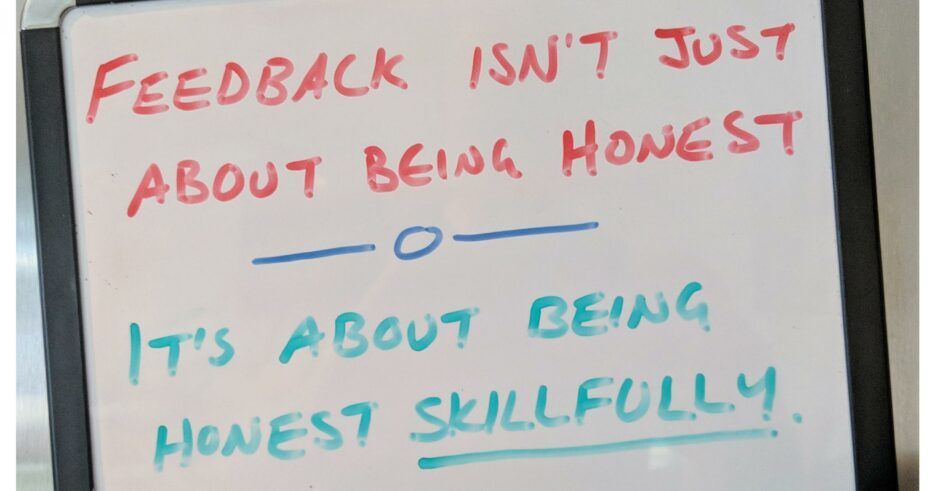All too frequently we think of projects in terms of schedules, requirements, budgets, resources and the like. We plan meticulously for them and hold onto the axiom that failing to plan is simply planning to fail. But how many of us actually plan for the human side of a project – the social, emotional and responsive elements of a project?
Let’s face it, we’ve all been in situations where (despite meticulous planning) we hear or say something along the lines of “Hmm! That’s not what I was expecting”, “Oh! I thought you meant this” or “Sorry! I wasn’t aware of that”.
Regular project checkpoints and review sessions can help reduce this BUT what if everyone was openly communicating throughout the project? What if everyone adopted and embraced proactive, honest, progressive feedback?
What is Feedback?
Feedback is the act (or perhaps art) of sharing reactions to someone else’s ideas, outputs, deliverables, feelings or behaviour. It is a way of letting others know to what extent you feel they are and/or could be furthering the objectives of the project.
It is about helping the other party understand your needs, how to achieve them and in what way you can support them in the endeavour (s). And by the way, it is also about recognizing the needs of the other party. Yes, feedback should be viewed as a bidirectional activity.
And don’t confuse feedback with critiquing, being forthright or just speaking the truth. Feedback is not simply about being honest….it’s about being honest skillfully.
Why is Skillful Feedback important?
Regular proactive, competent feedback ensures people don’t work on their own assumptions of how they are performing to meet the project deliverables and business needs.
Feedback is one of the most effective, valuable and easy to administer business tools at our disposal. Yet for the most part of it is Underused, poorly used and (in extreme cases) purposely Misused.
Performed skillfully, it is of tremendous value to the individual and the organization. But clumsy feedback, (no matter how well-intentioned), can severely damage relationships.
You cannot have excellence in management and leadership without excellence in the giving and receiving of feedback.
Giving Feedback
First, you must remember that while you may see flaws in a person’s work, they most likely think they are doing a good job. Acknowledge their positive intent by opening with something like “I appreciate your attention to detail, but we need…”
Avoid ANY hint of blame, judgement or criticism and replace “You” with “We” or “I”. Stay away from phrases like “You should…”, “You never…” and “Why did you…” and instead try “We need to…”, “I’d like to see…” and “How can we…”
Always talk about solutions rather than the problem. Discuss how you think things should be as you move forward, rather than dwell on what has happened, who did this, who said that, etc.
Give honest, positive feedback (what you value about the person) as well as developmental feedback (how things could be better).
Talk about your needs and concerns rather than subjective viewpoints. Be specific and talk about facts (what you saw/heard) rather than what you think or believe.
Make feedback a 2-way conversation by inviting the other party to talk about their needs using questions such as “What do you need from me?” or “How can I help with this?”.
Receiving Feedback
First, you must remember that perception is a reality for the person giving the feedback. You may see yourself as a hero but they may have a different viewpoint – not necessarily a villain but that you can be better in certain areas.
Don’t try to defend, justify or argue with the other person’s viewpoint. By doing that you are rejecting the feedback and hence the investment in the relationship.
Acknowledge the feedback even though you might not agree with it because this helps the other person feel that their viewpoint has been heard. If you disagree or need further clarification to try saying something like “I appreciate that and would like to know what you would like to see happen”.
Talk honestly about your needs and invite solutions to any problems that are brought up. For example, “What I need is more info/time/resources … do you have any suggestions on how we can make that happen?”
Stay calm, maintain eye contact, take notes if applicable and keep an open posture. Embrace the feedback and take all the help you can get.
Conclusion
Good working relationships are vital to the success of any project and this requires mutual understanding and acceptance (not necessarily agreement).
To facilitate this, it is imperative that Feedback is viewed as a conversation about your needs whilst respecting the needs of the other person. It’s not important that one view is right and the other is wrong, but it is imperative that both views matter.
This leads to collaborative problem solving and/or determining an even better way to work on tasks and activities.
On all projects (and in the workplace in general) if feedback is welcomed and used to create win-win results, everyone will feel more motivated, involved and willing to contribute.
This article is exclusive to The Business Transformation Network





